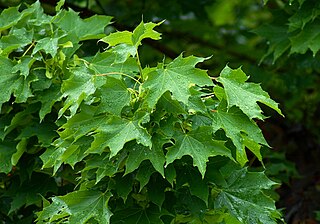
Acer platanoides, commonly known as the Norway maple, is a species of maple native to eastern and central Europe and western Asia, from France east to Russia, north to southern Scandinavia and southeast to northern Iran. It was brought to North America in the mid-1700s as a shade tree. It is a member of the family Sapindaceae.

Acer pseudoplatanus, known as the sycamore in the United Kingdom and the sycamore maple in the United States, is a flowering plant species in the soapberry and lychee family Sapindaceae. It is a large deciduous, broad-leaved tree, tolerant of wind and coastal exposure. It is native to Central Europe and Western Asia, from France eastwards to Ukraine, northern Turkey and the Caucasus and southwards in the mountains of northern Spain and Italy.

Acer campestre, known as the field maple, is a flowering plant species in the family Sapindaceae. It is native to much of continental Europe, Britain, southwest Asia from Turkey to the Caucasus, and north Africa in the Atlas Mountains. It has been widely planted, and is introduced outside its native range in Europe and areas of USA and Western Australia with suitable climate.

Acer circinatum, the vine maple, is a species of maple native to western North America, from southwest British Columbia to northern California, usually within 300 kilometres (190 mi) of the Pacific Ocean coast, found along the Columbia Gorge and Coastal Forest. It belongs to the Palmatum group of maple trees native to East Asia with its closest relatives being the Acer japonicum and Acer pseudosieboldianum. It can be difficult to distinguish from these species in cultivation. It is the only member of the Palmatum group that resides outside of Asia.
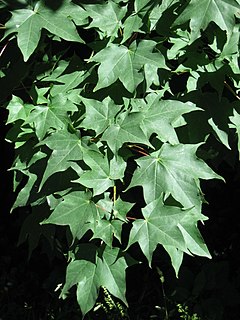
Acer cappadocicum, the Cappadocian maple, is a maple native to Asia, from central Turkey east along the Caucasus, the Himalaya, to southwestern China.

Acer ginnala, the Amur maple, is a plant species with woody stems native to northeastern Asia from easternmost Mongolia east to Korea and Japan, and north to the Russian Far East in the Amur River valley. It is a small maple with deciduous leaves that is sometimes grown as a garden subject or boulevard tree.

Acer tataricum, the Tatar maple or Tatarian maple, is a species of maple widespread across central and southeastern Europe and temperate Asia, from Austria and Turkey east as far as Japan and the Russian Far East. The species is named after the Tatar peoples of southern Russia; the tree's name is similarly commonly also spelled "Tartar" in English.
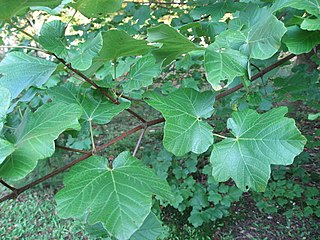
Acer opalus, the Italian maple, is a species of maple native to the hills and mountains of southern and western Europe, from Italy to Spain and north to southern Germany, and also in northwest Africa in Morocco and Algeria.
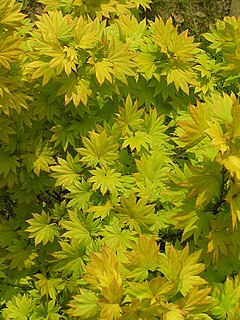
Acer shirasawanum, the Shirasawa maple or fullmoon maple, is a species of maple native to Japan, on central and southern Honshū, Shikoku, and Kyūshū.

Acer japonicum, the Amur maple, downy Japanese-maple or fullmoon maple, is a species of maple native to Japan, on Honshū, Hokkaidō, Kyūshū, and also southern Korea.

Acer × zoeschense is a hybrid maple, a cross between Acer campestre, and either Acer lobelii or Acer cappadocicum. While Field Maple parentage is universally accepted, the second parent is uncertain, though the tree's extensive production of root sprouts favours A. cappadocicum over A. lobelii. It takes its name from Zöschen Nurseries in Germany, where it first appeared as a garden hybrid at some time before 1870.
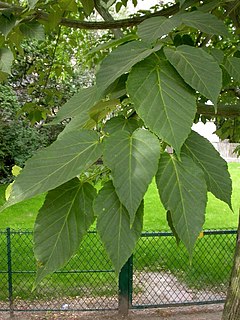
Acer davidii, or Père David's maple, is a species of maple in the snakebark maple group. It is native to China, from Jiangsu south to Fujian and Guangdong, and west to southeastern Gansu and Yunnan.

Acer sieboldianum is a species of maple native to Japan and common in the forests of Hokkaidō, Honshū, Shikoku and Kyūshū Islands; in the south of the range it is restricted to mountain forests. It is named after Philipp Franz von Siebold.

Acer cissifolium is a maple native to Japan, from southern Hokkaidō south through Honshū and Shikoku to Kyūshū.
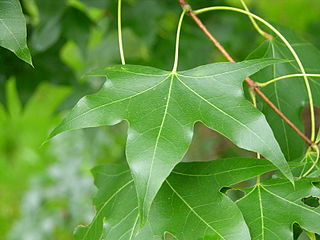
Acer truncatum, the Shantung maple, Shandong maple, or purpleblow maple, is a maple native to northern China, in the provinces of Gansu, Hebei, Henan, Jiangsu, Jilin, Liaoning, Inner Mongolia, Shaanxi, Shandong, Shanxi, and to Korea.
Acer miaotaiense is a species of maple endemic to China. It grows in mixed forests of southeastern Gansu, southwestern Henan, northwestern Hubei, southern Shaanxi, and Zhejiang.

Acer miyabei is a species of maple native to Japan, where it occurs in Hokkaidō and the Tōhoku region in northern Honshū.

Acer sempervirens, the Cretan maple, is a species of maple native to southern Greece and southern Turkey.

Acer hyrcanum is a maple species sometimes referred to as Balkan maple. It grows in southeastern Europe and western Asia.


















